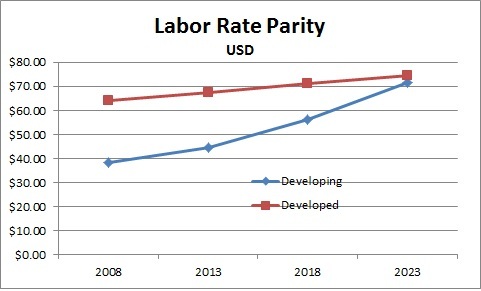The gap in labour rates for maintenance, repair and overhaul in North America compared to emerging regions is narrowing at a faster-than-anticipated rate, says Dave Marcontell, president of aviation consultancy Team SAI.
"We're seeing substantial growth in labour rates in emerging and developing regions," says Marcontell, adding, "It's accelerating, happening faster than expected."
By 2023, labour rates for MRO in developing and developed countries will be very similar, he says. As these labour rates increase it will eventually be less economic for airlines to ferry their aircraft abroad - especially for narrowbody aircraft.
"What you're seeing is that it's not going to make sense," says Marcontell.
Marcontell points to two main factors driving the trend. The first is an increase in air traffic in emerging regions, which is filing up MROs abroad with local demand, says Marcontell. About 72% of maintenance work occurs in the region of an airline's home base, he explains. So, as air traffic demand increases in markets like the Asia-Pacific, those maintenance shops are filling up with demand from airlines based in those regions.
Team SAI's research shows that 84% of all MRO work is outsourced. Seventy-two percent is sent to third-party providers. Almost all engine maintenance is outsourced, with as much as 33% sent to different regions. About 85% of component maintenance is sent to third party MRO providers or OEMs, the research shows, but just 12% goes to different regions. Sixty-one percent of heavy maintenance work is outsourced, the consultancy says, with only 17% done outside of the region that created the demand for it.
The airline industry will see passenger numbers increase 5.3% per year between 2012 and 2016, said the International Air Transport Association in a forecast released in late 2012. For domestic air travel, the top five markets by 2016 are expected to be the USA with 710.2 million passengers per year, China with 415 million passengers, Brazil with 118.9 million passengers, India with 107.2 million and Japan with 93.2 million.
Consulting firm ICF SH&E also mentioned a pattern of the migration of heavy maintenance work from countries in Asia back to North America last year at the 2012 MRO Americas conference. In a forecast presented in April 2012, the firm said that high fuel prices increasing costs for ferry flights contributed to the trend, combined with a decline in the average labour hours per check, excess facility space in North America and skills shortages in Asia that are causing labour rates to rise.
The gap between labour rates in emerging markets versus the USA is closing in, Team SAI's analysis shows. Based on maintenance data derived from the consulting firm's industry sources, the average labour rate in North America for heavy maintenance is $55, compared to $45 in China, $41 in Latin America and the Caribbean, and $49 in the Asia-Pacific region. Western Europe has the highest average labour rate at $80.
In 2008, North America saw an average labour rate of $54, versus $44 in China, $34 in Latin America and the Caribbean, $44 in Asia-Pacific and $74 in Western Europe, Team SAI's analysis shows.
In the future, countries in the Asia-Pacific region, China, India and Latin America are expected to have an average labour rate of $71.39 by 2023, the Team SAI data shows. By comparison, North America and Western Europe are expected to see average labour rates at $74.50 in 10 years.

Source: Team SAI Consulting
The gap in manufacturing labour rates between the USA and China has been steadily decreasing since before the downturn of 2008, data from the US Bureau of Labour Statistics shows.
The index of hourly compensation costs in China for manufacturing as a percentage of those for US employees steadily rose between 2002 and 2008, data from the US Bureau of Labour Statistics shows. That index doubled from 2.1 in 2002 to 4.2 in 2008.
While it is too early to say for sure how MRO labour rates will behave over the next few years, some of the vacant North American facility space that ICF SH&E mentioned in last year's MRO forecast has been claimed by firms expanding or setting up new shops, signalling new competition within the market.
For example, AAR delivered the first aircraft from its new 188,000 square ft (17,465 sq m) facility in Duluth late last year, and continues ramping up maintenance lines there for narrowbody aircraft. Miami-based Commercial Jet announced last week that it was moving into Pemco's old facility at Dothan Regional Airport in Alabama to create a 400,000 ft2 (37,161 m2) facility for heavy maintenance and cargo conversions.
In the USA alone, the civil maintenance, repair and overhaul industry employs about 306,585 people, 200,000 of which are employed by Part 145 repair stations, a recent study by ICF SH&E shows. The industry generated $47 billion in economic activity in 2012, the study showed. California and Texas generated the most economic activity, followed by Arizona, Washington, Georgia and Connecticut.
Source: Air Transport Intelligence news
















